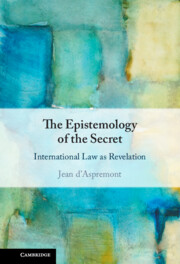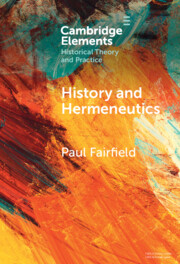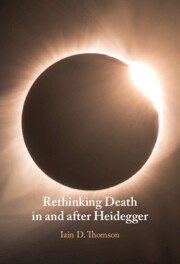Refine search
Actions for selected content:
163 results
Introduction
-
- Book:
- Anton Webern at the Dawn of Modernism
- Published online:
- 21 August 2025
- Print publication:
- 04 September 2025, pp 1-10
-
- Chapter
- Export citation
The Rumpelstiltskin effect: therapeutic repercussions of clinical diagnosis
-
- Journal:
- BJPsych Bulletin , FirstView
- Published online by Cambridge University Press:
- 22 August 2025, pp. 1-5
-
- Article
-
- You have access
- Open access
- HTML
- Export citation

The Epistemology of the Secret
- International Law as Revelation
-
- Published online:
- 23 July 2025
- Print publication:
- 09 October 2025
Chapter 6 - Praxis Epistemology III
-
- Book:
- Vico and the Maker's Knowledge Tradition
- Published online:
- 27 June 2025
- Print publication:
- 17 July 2025, pp 185-221
-
- Chapter
- Export citation
Chapter 11 - Mapping the Value Changes in Depression and Recovery
- from Part III - Common Clinical Conditions: The Relevance and Usefulness of a Values-Based Approach
-
-
- Book:
- Values in Psychiatry
- Published online:
- 24 June 2025
- Print publication:
- 10 July 2025, pp 157-173
-
- Chapter
- Export citation
Chapter 14 - A New Way of Doing Research in Psychiatry
- from Part III - Common Clinical Conditions: The Relevance and Usefulness of a Values-Based Approach
-
-
- Book:
- Values in Psychiatry
- Published online:
- 24 June 2025
- Print publication:
- 10 July 2025, pp 214-220
-
- Chapter
- Export citation
Acknowledging existential moments and meaning-making in palliative care: A hermeneutic study of physicians’ experience
-
- Journal:
- Palliative & Supportive Care / Volume 23 / 2025
- Published online by Cambridge University Press:
- 20 June 2025, e120
-
- Article
-
- You have access
- Open access
- HTML
- Export citation

History and Hermeneutics
-
- Published online:
- 06 June 2025
- Print publication:
- 03 July 2025
-
- Element
- Export citation
How to read ambiguity well: Reading ambiguity in Luke and Acts
-
- Journal:
- Scottish Journal of Theology / Volume 78 / Issue 2 / May 2025
- Published online by Cambridge University Press:
- 07 April 2025, pp. 91-103
- Print publication:
- May 2025
-
- Article
-
- You have access
- Open access
- HTML
- Export citation
7 - Healing on the Sabbath and Places of Honor at a Feast (Lk 14:1–11)
-
- Book:
- Luke's Unique Parables
- Published online:
- 28 February 2025
- Print publication:
- 06 March 2025, pp 71-90
-
- Chapter
- Export citation
Chapter 1 - What Is History Like?
-
- Book:
- Teaching History in Higher Education
- Published online:
- 07 February 2025
- Print publication:
- 20 February 2025, pp 24-60
-
- Chapter
- Export citation
Sarah Grimké as Biblical Commentator
-
- Journal:
- Harvard Theological Review / Volume 118 / Issue 1 / January 2025
- Published online by Cambridge University Press:
- 10 March 2025, pp. 134-158
- Print publication:
- January 2025
-
- Article
-
- You have access
- Open access
- HTML
- Export citation

Rethinking Death in and after Heidegger
-
- Published online:
- 18 December 2024
- Print publication:
- 05 December 2024
Chapter 6 - Revisiting Gadamer’s Critique of Collingwood
- from Part I - Situating Collingwood: Beyond Idealism
-
-
- Book:
- Interpreting R. G. Collingwood
- Published online:
- 22 November 2024
- Print publication:
- 05 December 2024, pp 102-120
-
- Chapter
- Export citation
3 - Heidegger on Death and the Nothing It Discloses
- from Part I - Rethinking Death in Heidegger
-
- Book:
- Rethinking Death in and after Heidegger
- Published online:
- 18 December 2024
- Print publication:
- 05 December 2024, pp 100-129
-
- Chapter
- Export citation
1 - Death and Demise in Being and Time
- from Part I - Rethinking Death in Heidegger
-
- Book:
- Rethinking Death in and after Heidegger
- Published online:
- 18 December 2024
- Print publication:
- 05 December 2024, pp 3-73
-
- Chapter
- Export citation
5 - White’s Time and Death
- from Part II - Rethinking Death after Heidegger
-
- Book:
- Rethinking Death in and after Heidegger
- Published online:
- 18 December 2024
- Print publication:
- 05 December 2024, pp 159-180
-
- Chapter
- Export citation
Preface
-
- Book:
- Rethinking Death in and after Heidegger
- Published online:
- 18 December 2024
- Print publication:
- 05 December 2024, pp xi-xvii
-
- Chapter
- Export citation
Hermann Cohen’s Neo-Kantian Ethical Socialism
-
- Journal:
- Kantian Review / Volume 29 / Issue 4 / December 2024
- Published online by Cambridge University Press:
- 09 December 2024, pp. 607-628
- Print publication:
- December 2024
-
- Article
-
- You have access
- Open access
- HTML
- Export citation
Stanza permutation in the “Guo feng” 國風 and an examination of the hermeneutical tradition of “orderly progression”
-
- Journal:
- Bulletin of the School of Oriental and African Studies / Volume 88 / Issue 1 / February 2025
- Published online by Cambridge University Press:
- 21 November 2024, pp. 123-147
- Print publication:
- February 2025
-
- Article
-
- You have access
- Open access
- HTML
- Export citation
